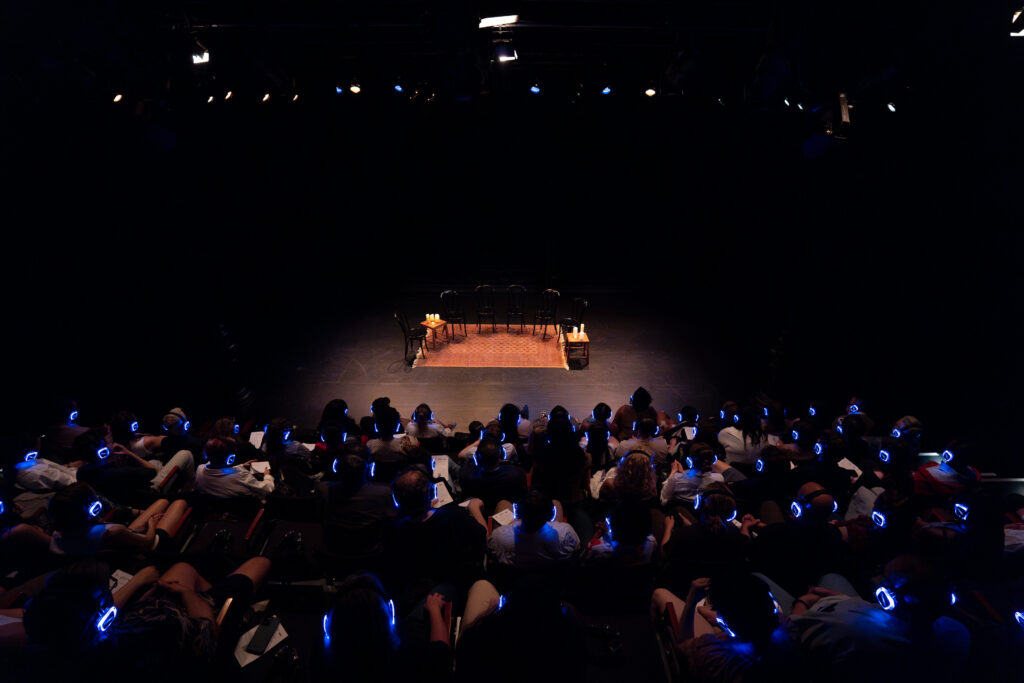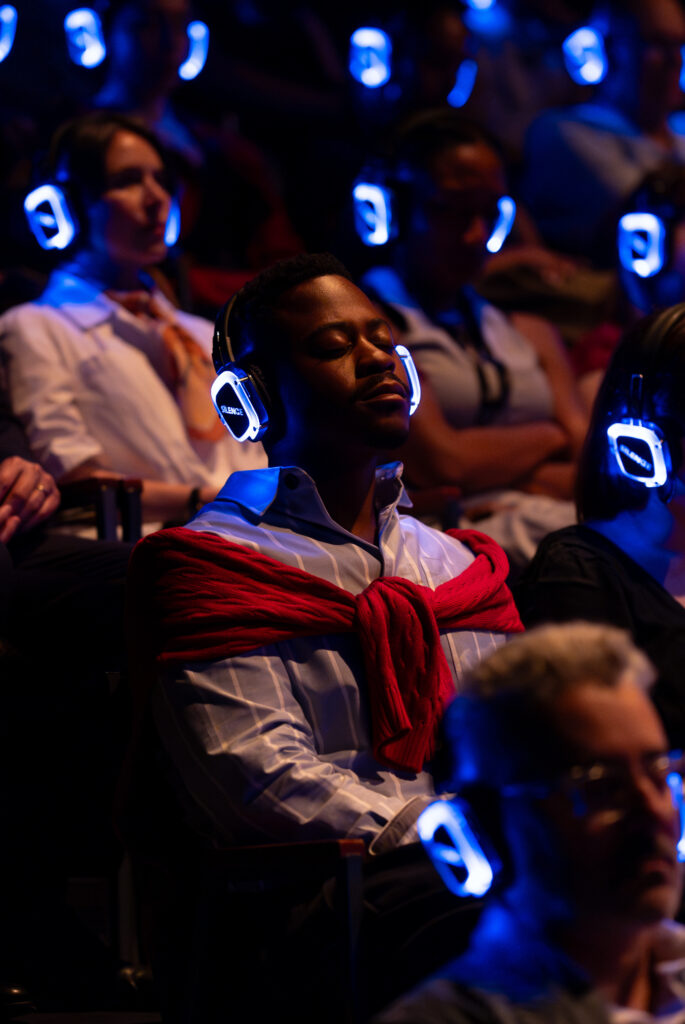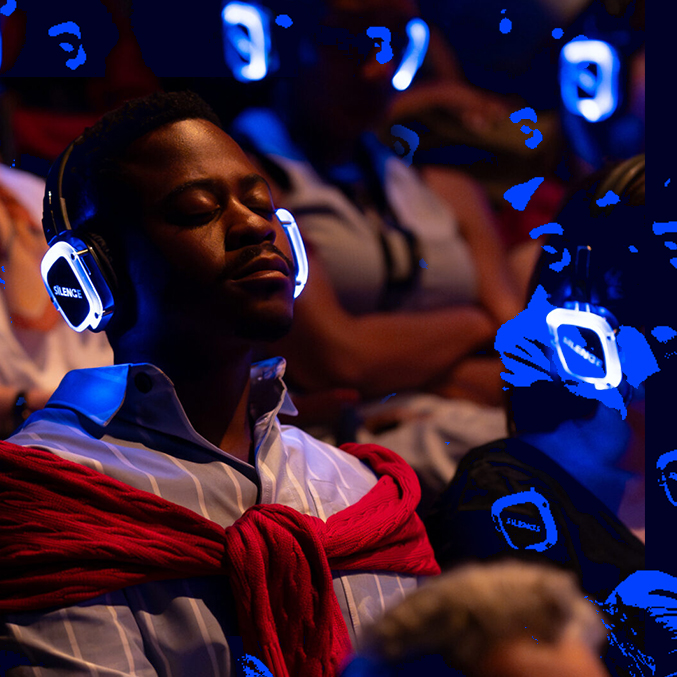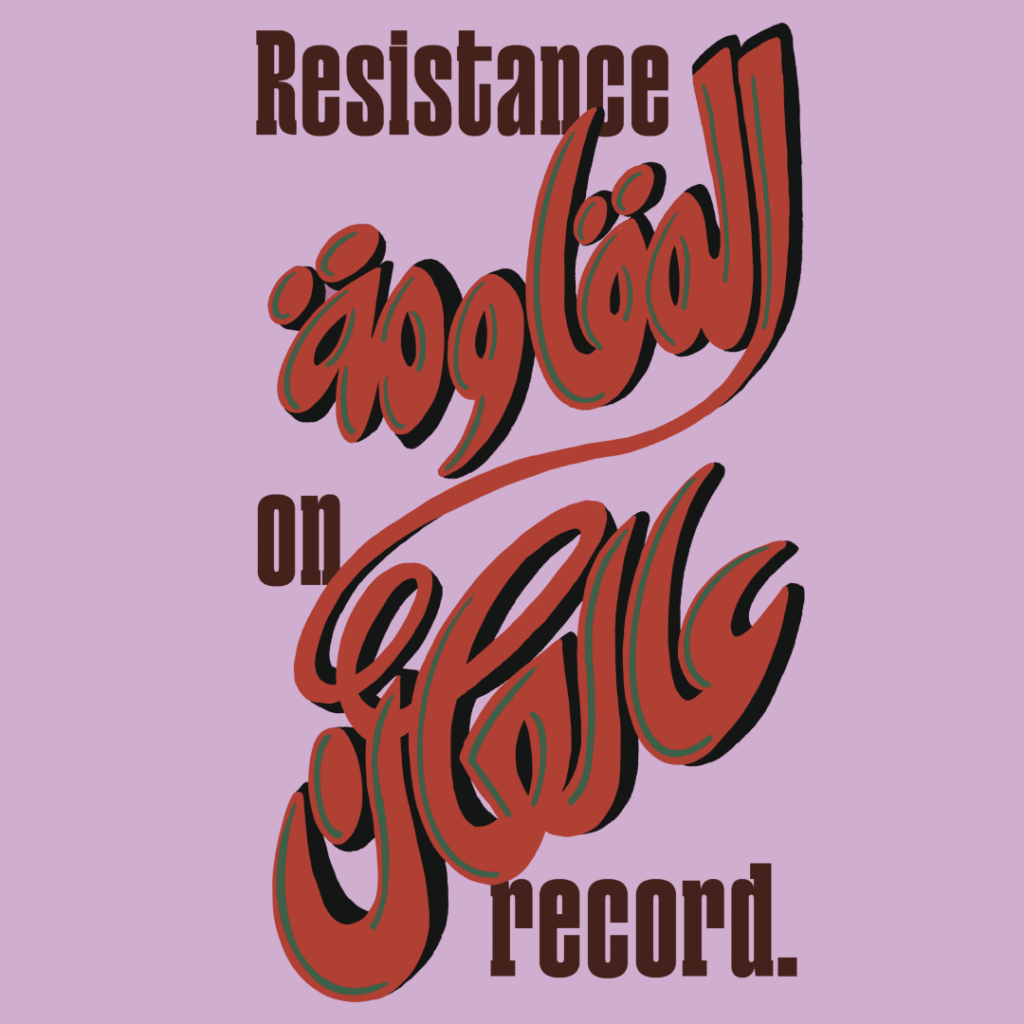Alone in a Crowd at Tribeca
It’s a fool’s errand to count all the adaptations of “Hamlet.”
It has been retold from the perspective of the prince’s fake friends (Tom Stoppard’s “Rosencrantz and Guildenstern Are Dead”). A VR headset lets people inhabit the Ghost’s POV (“Hamlet 360: Thy Father’s Spirit”). Ophelia is a playable video game character (“Elsinore”). The plot itself has been retrofitted into everything from a womb (“Nutshell” by Ian McEwan) to a Canadian brewery (the Rick Moranis-Dave Thomas cult classic “Strange Brew”).
While it would be impossible to catalog every reinterpretation, it’s quite possible that none have been able to do what the Make-Believe Association has done through the power of audio.
The Chicago-based independent production company, which premiered their “Hamlet,” at New York’s Public Theater for the Tribeca Festival last week, made a critical perspective shift to William Shakespeare’s version: the plot is laid out entirely from Hamlet’s purview over six episodes.
And by turning the actor playing Hamlet, Daniel Kyri, into a human microphone, the Make-Believe Association has perhaps created the most intimate experience of “Hamlet” ever made — transporting the audience literally into the head of the tragic prince himself.
Centering the Dane
Premiere attendees (including one host of “The Daily,” Michael Barbaro, not to goss) were led through a silent disco headphone tutorial by the production’s adapter and director, Jeremy McCarter. House lights dimmed, and Daveed Diggs’s familiar voice commanded us to listen well — with headphones — to this “mad tale for mad times” and “hear only what a grief-riddled prince hears: the voices around him, the voices within.”
We sat, a quiet sea of blue-lighted headphones in front of a stage that would remain unoccupied for the duration of the performance. Suddenly, with an unnerving gasp, we were embodying the sound. Fabric shifted as echoing footsteps beneath us came to a halt. A hitched breath was let out from what felt like our own throat. Is it nerves? A prelude to tears? A sharp inhale of resolve, then we – now Hamlet – pushed open a door and stepped into the boisterous court of our once uncle, now stepfather, King Claudius.

Yes, Ham-heads (Hamlettes?), this production nixes the opening scene of the ghost appearing to Elsinore castle guards. To tell Hamlet’s side of the story, the script had to drop every scene he’s not privy to.
“The thing really, truly, was an experiment,” said McCarter in an interview. “We didn’t know if it was going to work.” While working on a previous Tribeca-selected audio drama, “Lake Song,” with Tony Award-winning sound designer Mikhail Fiksel, McCarter became intrigued by the way headphones can obliterate the space between action and audience.
“I realized you can make people feel like they’re inside somebody else’s head,” McCarter said. “We started to think, well, if we can put people inside someone’s head, maybe this is the moment to try to do that with the play most famous for putting an audience inside a person’s head.”
But before he and Fiksel could start playing with microphones and castle foley, McCarter needed to figure out if the story even held together from Hamlet’s point of view. “There are crucial plot elements that are delivered to the audience when Hamlet is offstage in a conventional production.” He wondered, “Is it possible to rearrange the language from Shakespeare to make the plot cohere?”
To try, he took the descriptions of Hamlet’s off-stage behavior and recreated them as action scenes. Ophelia’s relaying to her father of an unsettling conversation with Hamlet becomes a new scene that drops us into that encounter instead.
“Otherwise, the story will make no sense,” McCarter said. “We won’t know who Ophelia is. We won’t understand why people have reason to think that Hamlet is starting to crack up.”

McCarter’s “radically faithful” approach to rewriting “Hamlet” received a blessing from The Public Theater’s Shakespeare scholar, James Shapiro. Now, carefully placed lines and spatial audio techniques work together to marry Hamlet’s internal and external experiences in a way that feels both textually true and surprisingly new. Soliloquies typically delivered alone on stage are interwoven through busier scenes that get ducked beneath Hamlet’s internal monologues.
It’s a fastidious and entertaining reworking of the script. But it only gels into transportive immersion thanks to Mikhail Fiksel’s sound design.
Cracking Hamlet’s skull
“The original idea was, we turn our Hamlet into a binaural microphone,” Fiksel told me. “What Hamlet hears is how we experience it.”
But it turns out that doesn’t work on its own, particularly in dynamic scenes, or anything that requires recording over distances beyond three or four feet.
That was distracting to Fiksel, as it made the technology noticeable in the listen. Being aware of the microphones is a nonstarter for him. “That’s always been my approach to audio work: I wanna remove the mic out of the equation,” Fiksel said. “I don’t want the actor to be aware of it. I don’t want them acting to the microphone, I want them to be acting to each other and to their environment. So it ended up being a bit more of a hybrid binaural recording.”
In addition to the binaural ear mics, Fiksel added a halo rig centered on Kyri’s forehead to stabilize the sound. He also deployed traditional shotgun mics and lavaliers on every actor to seamlessly place Hamlet’s head anywhere within the soundscape. Fiksel crossfaded between lavs, shotguns, a stationary binaural microphone, and the rig on Kyri’s head when Hamlet began speaking to someone. The ensuing dialogue didn’t yield the most pristine audio, but that’s what thrilled Fiksel the most.
“We are essentially hearing his speech the way we hear our speech. It resonates through the skull. It feels like it’s coming from here,” Fiksel said, pointing into his chin, “rather than out in front of us. It’s slightly boxy, some of the sibilants are sort of absent. But it felt like: Oh, this is me, speaking. This makes it worth it. This justifies rigging up our poor actor with a bunch of microphones, like the audio version of motion capture.”
An old role in a new form
“I was miked to all high heavens,” Kyri told me.
Over the course of the 20 recording sessions at Tightrope Recording Studio in Chicago, almost all of which Kyri was present for, he was able to put aside any self-consciousness about being covered in mics, or bringing an audience inside his head. Kyri — who plays the role with a vulnerable innocence and is mercifully skilled at making iambic pentameter completely legible to the ear — trusted McCarter, Fiksel and associate director Sydney Charles to bring his performance to 3D life. He just focused on telling the story of Hamlet’s evolution of grief.
“That leads us to his humanity,” Kyri said. “He’s not a tyrant. He’s not a monster. He’s not an insane person. He is a person who doesn’t know how to live in this world in the aftermath of this thing that changed it.”
Only in listening to the final mix did Kyri realize just how visceral a performance he and his nuanced breathwork delivered in this production.
“Those sounds are so close, it really does begin to feel as though the moments are happening to you in real time,” he said. “ There’s goosebumps, or a prickling on the back of my neck, or a flinch. You begin to embody the experience. You can feel yourself beginning to unravel, and using whatever tool at your disposal to stave that off.”
For Kyri’s Hamlet, that tool is often his precise, emotive breath, which Fiksel wielded along with other bodily sound effects to provide the emotional shading that a musical score would typically supply.
It results in an “almost automatic system response,” Fiksel said proudly. “Your breathing will start to synchronize with his. Your heartbeat will begin to pound.” So as Hamlet succumbs to the voices in his head, you’re already physically primed to go there with him.
The production team made all sorts of restrictive rules to keep from breaking that hard-won synchrony with the listener. Traditional scoring techniques couldn’t actually emotionally elevate the performance; it broke the spell. “Suddenly it was like, ‘Oh wait, there’s another viewer here that is not Hamlet,’” Fiksel explained. So all the music remained diegetic in the piece, returning out of context only when it replays in Hamlet’s head.
Kyri is grateful the sound design, like the book, tried to stay so true to the source despite being performed through very modern technology.
“There is something really fascinating about this old traditional theater text meeting this new technology in a medium that is a reestablishment of what existed before — audio drama being the progeny of radio drama,” he said. “It’s an amalgamation of storytelling mediums that has led us to this production of ‘Hamlet.’ Its value is that it is pretty close to what Shakespeare wrote, and as close as we can get to his intent 400 years later.”

The urgent message from 1600
So in such a decidedly faithful treatment of this story, what does the Make-Believe Association’s “Hamlet” have to say to a 2025 audience?
McCarter found his answer in James Shapiro’s book, “1599.” As it turns out, Shakespeare’s original “Hamlet” was itself an adaptation.
“Shakespeare was rewriting an earlier play that he knew his audience was familiar with,” McCarter said. “He rewrote it in part because he wanted his audience to register what he could see happening, which is that their society was breaking down. There were massive changes underway in terms of politics and in terms of the way they thought about the afterlife. Huge changes in the world that had been unthinkable relatively recently. When I read that, it just clicked all at once.”
He sees the Make-Believe Association’s production as being in conversation with Shakespeare’s “Hamlet.”Just as Shakespeare’s contemporaries were familiar with his play’s source material, most people who encounter this podcast are probably familiar with his “Hamlet.” “We are — like Shakespeare according to Shapiro — putting our version next to a version they already know and hoping they feel the differences,” McCarter said.
And that difference this time is where the story is coming from: Hamlet himself. “When you hear it from his perspective, you have a sharp appreciation for why he feels paranoid, why he’s isolated,” McCarter said. “Every scene, he is being confronted by yet another thing that his picture of the world can’t accommodate. That sensation of claustrophobia, of impossible things continuing to happen, of not knowing whom you can trust — that just feels very much like 2025 to me. ”
As the panel of its makers remarked after Episode 1 finished playing in our ears, the Tribeca premiere mirrored Hamlet’s tragic irony in another way: a room full of people, listening to voices in their heads. Isolated, experiencing grief and bewilderment, but in a crowd.
“That sort of isolation and desperation and loneliness — it feels very familiar,” Fiksel agreed. “This idea of madness and wondering, am I going mad, or is the world going mad? I think that’s what’s resonating with a lot of us today.”

“Who among us today does not feel like the rug has been pulled out from under them?” Kyri asked. “That is, to me, the most valuable thing Hamlet is experiencing. It’s this whirling frenzy he is at the center of. He is unmoored and trying to catch up and contextualize, and trying desperately to rebuild the world that he knew in the aftermath of having it blow up. It becomes a tale of attempting to adapt to all of these massive, sudden, irreversible changes. It’s what we all have to wrestle with.”
When laid out from the prince’s point of view, however, McCarter found hope, not futility, at the bloody end of “Hamlet.”
“The real discovery for me in hearing the story this way is that the point isn’t who dies at the end — who kills or gets killed,” he said. “The point is: Hamlet goes through 17 different kinds of hell in the course of this story, and somehow, by the end of it, finds peace. It’s a coming of age story of a young man figuring out how to think and feel about a difficult, confounding world. What’s tragic is that once he finds those insights, he has about an hour to live.”
But Hamlet finds them nonetheless.
“These days, when we are confronting that kind of chaos, I find that surprisingly consoling.”
Phoebe Lett is a writer, producer, and performer based in Brooklyn.










